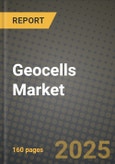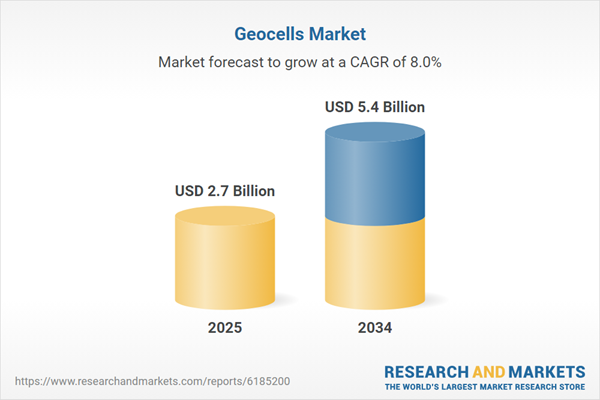The global geocells market is experiencing steady growth, driven by increasing infrastructure development, environmental concerns, and the need for cost-effective soil stabilization solutions. Geocells, also known as cellular confinement systems, are widely used in road construction, slope protection, erosion control, and load support applications. Their ability to improve soil performance while reducing material usage makes them a preferred solution for sustainable construction. Governments and private developers are increasingly adopting geocells to enhance the longevity and durability of infrastructure projects. Additionally, stringent environmental regulations promoting erosion control and sustainable land management have further fueled demand. As industries seek efficient and eco-friendly alternatives for soil reinforcement, geocells continue to gain traction across diverse applications, ranging from mining and agriculture to urban infrastructure and disaster mitigation projects.
The geocells market witnessed significant advancements, driven by technological innovations and increasing infrastructure investments. Governments worldwide ramped up spending on road rehabilitation and flood mitigation projects, creating new opportunities for geocell manufacturers. The year also saw a rising focus on geosynthetic solutions with enhanced durability and load-bearing capacity, leading to the introduction of new materials and polymer blends. Sustainability became a key driver, with an increased emphasis on using recycled and biodegradable raw materials in geocell production. Additionally, digitalization played a growing role, with engineering firms leveraging simulation tools and AI-driven designs to optimize geocell applications. Supply chain disruptions persisted in some regions, impacting raw material availability and pricing. However, strategic collaborations between geosynthetics companies and infrastructure firms helped mitigate these challenges, ensuring project continuity and market expansion.
The geocells market is expected to benefit from rising urbanization, climate resilience initiatives, and the integration of smart construction technologies. The adoption of AI-driven predictive maintenance and automated installation techniques is anticipated to streamline project execution and reduce labor costs. Additionally, regulatory frameworks promoting eco-friendly construction materials will drive further innovation in geocell production. Emerging economies, particularly in Asia-Pacific and Latin America, are expected to witness increased geocell adoption due to large-scale infrastructure investments and the need for erosion control solutions. The demand for high-performance geocells with enhanced chemical resistance and longer service life will likely rise, encouraging R&D investments in advanced polymer formulations. However, market players will need to navigate fluctuating raw material costs and competition from alternative soil stabilization technologies. As sustainability and efficiency remain top priorities, geocells will play an integral role in modern infrastructure development.
Key Insights: Geocells Market
- Growing Demand for Sustainable Geosynthetics: The shift toward environmentally friendly infrastructure solutions is driving the use of recycled and biodegradable materials in geocell production.
- Increased Use in Flood Control and Disaster Management: Governments and municipalities are adopting geocells for flood mitigation and slope stabilization to enhance climate resilience.
- Technological Advancements in Polymer Formulations: Innovations in high-performance polymer blends are enhancing the strength, flexibility, and longevity of geocells for demanding applications.
- Expansion in Emerging Markets: Rapid urbanization and infrastructure development in Asia-Pacific, Latin America, and Africa are fueling demand for geocells in construction projects.
- Integration of AI and Digital Tools: The adoption of AI-driven design simulations and automated installation methods is improving project efficiency and cost-effectiveness.
- Rising Infrastructure Development: Increasing investments in roads, railways, and urban infrastructure projects are driving demand for geocells as a cost-effective soil stabilization solution.
- Stringent Environmental Regulations: Growing regulatory emphasis on erosion control and sustainable construction materials is encouraging the widespread adoption of geocells.
- Cost and Material Efficiency: Geocells reduce the need for high-cost aggregates and concrete, making them an attractive alternative for budget-conscious infrastructure projects.
- Growing Demand for Resilient Infrastructure: Climate change and extreme weather events are increasing the need for geocell-based solutions to enhance the durability of roads, embankments, and flood-prone areas.
- Fluctuating Raw Material Prices: The volatility in polymer and resin prices, driven by supply chain disruptions and geopolitical factors, poses a challenge for geocell manufacturers in maintaining cost competitiveness.
Geocells Market Segmentation
By Type
- High-Density Polyethylene
- Polypropylene
- Polyester
- Other Types
By Design Type
- Perforated
- Non Perforated
By Application
- Load Support
- Slope and Channel Protection
- Retention Of Walls
- Other Applications
Key Companies Analysed
- Presto Geosystems
- Strata Systems
- Armtec Infrastructure
- Maccaferri SPA
- Polymer Group Ltd
- TMP Geosynthetics
- Wall Tag Pte Ltd.
- Tensar International
- PRS Geo- Technologies
- Terram Geosynthetics
- TenCate Geosynthetics
- Miakom Group
- ACE Geosynthetics
- Officine Maccaferri
- Polyfabrics Australasia Pty Ltd.
- HUESKER Synthetic GmbH
- Atarfil
- ABG Geosynthetics
- Asahi Kasei
- CeTeau Group
- Titan Environmental Containment
- Carthage Mills
- Wrekin Products Ltd.
- Hindustan National Glass & Industries Ltd.
- TechFab India Industries Ltd.
- BOSTD Geosynthetics Qingdao Ltd.
- AllianceGeo Inc.
- GPT Industries
Geocells Market Analytics
The report employs rigorous tools, including Porter’s Five Forces, value chain mapping, and scenario-based modeling, to assess supply-demand dynamics. Cross-sector influences from parent, derived, and substitute markets are evaluated to identify risks and opportunities. Trade and pricing analytics provide an up-to-date view of international flows, including leading exporters, importers, and regional price trends.Macroeconomic indicators, policy frameworks such as carbon pricing and energy security strategies, and evolving consumer behavior are considered in forecasting scenarios. Recent deal flows, partnerships, and technology innovations are incorporated to assess their impact on future market performance.
Geocells Market Competitive Intelligence
The competitive landscape is mapped through proprietary frameworks, profiling leading companies with details on business models, product portfolios, financial performance, and strategic initiatives. Key developments such as mergers & acquisitions, technology collaborations, investment inflows, and regional expansions are analyzed for their competitive impact. The report also identifies emerging players and innovative startups contributing to market disruption.Regional insights highlight the most promising investment destinations, regulatory landscapes, and evolving partnerships across energy and industrial corridors.
Countries Covered
- North America - Geocells market data and outlook to 2034
- United States
- Canada
- Mexico
- Europe - Geocells market data and outlook to 2034
- Germany
- United Kingdom
- France
- Italy
- Spain
- BeNeLux
- Russia
- Sweden
- Asia-Pacific - Geocells market data and outlook to 2034
- China
- Japan
- India
- South Korea
- Australia
- Indonesia
- Malaysia
- Vietnam
- Middle East and Africa - Geocells market data and outlook to 2034
- Saudi Arabia
- South Africa
- Iran
- UAE
- Egypt
- South and Central America - Geocells market data and outlook to 2034
- Brazil
- Argentina
- Chile
- Peru
Research Methodology
This study combines primary inputs from industry experts across the Geocells value chain with secondary data from associations, government publications, trade databases, and company disclosures. Proprietary modeling techniques, including data triangulation, statistical correlation, and scenario planning, are applied to deliver reliable market sizing and forecasting.Key Questions Addressed
- What is the current and forecast market size of the Geocells industry at global, regional, and country levels?
- Which types, applications, and technologies present the highest growth potential?
- How are supply chains adapting to geopolitical and economic shocks?
- What role do policy frameworks, trade flows, and sustainability targets play in shaping demand?
- Who are the leading players, and how are their strategies evolving in the face of global uncertainty?
- Which regional “hotspots” and customer segments will outpace the market, and what go-to-market and partnership models best support entry and expansion?
- Where are the most investable opportunities - across technology roadmaps, sustainability-linked innovation, and M&A - and what is the best segment to invest over the next 3-5 years?
Your Key Takeaways from the Geocells Market Report
- Global Geocells market size and growth projections (CAGR), 2024-2034
- Impact of Russia-Ukraine, Israel-Palestine, and Hamas conflicts on Geocells trade, costs, and supply chains
- Geocells market size, share, and outlook across 5 regions and 27 countries, 2023-2034
- Geocells market size, CAGR, and market share of key products, applications, and end-user verticals, 2023-2034
- Short- and long-term Geocells market trends, drivers, restraints, and opportunities
- Porter’s Five Forces analysis, technological developments, and Geocells supply chain analysis
- Geocells trade analysis, Geocells market price analysis, and Geocells supply/demand dynamics
- Profiles of 5 leading companies - overview, key strategies, financials, and products
- Latest Geocells market news and developments
Additional Support
With the purchase of this report, you will receive:- An updated PDF report and an MS Excel data workbook containing all market tables and figures for easy analysis.
- 7-day post-sale analyst support for clarifications and in-scope supplementary data, ensuring the deliverable aligns precisely with your requirements.
- Complimentary report update to incorporate the latest available data and the impact of recent market developments.
This product will be delivered within 1-3 business days.
Table of Contents
Companies Mentioned
- Presto Geosystems
- Strata Systems
- Armtec Infrastructure
- Maccaferri SPA
- Polymer Group Ltd.
- TMP Geosynthetics
- Wall Tag Pte Ltd.
- Tensar International
- PRS Geo- Technologies
- Terram Geosynthetics
- TenCate Geosynthetics
- Miakom Group
- ACE Geosynthetics
- Officine Maccaferri
- Polyfabrics Australasia Pty Ltd.
- HUESKER Synthetic GmbH
- Atarfil
- ABG Geosynthetics
- Asahi Kasei
- CeTeau Group
- Titan Environmental Containment
- Carthage Mills
- Wrekin Products Ltd.
- Hindustan National Glass & Industries Ltd.
- TechFab India Industries Ltd.
- BOSTD Geosynthetics Qingdao Ltd.
- AllianceGeo Inc.
- GPT Industries
Table Information
| Report Attribute | Details |
|---|---|
| No. of Pages | 160 |
| Published | October 2025 |
| Forecast Period | 2025 - 2034 |
| Estimated Market Value ( USD | $ 2.7 Billion |
| Forecasted Market Value ( USD | $ 5.4 Billion |
| Compound Annual Growth Rate | 7.9% |
| Regions Covered | Global |
| No. of Companies Mentioned | 28 |









